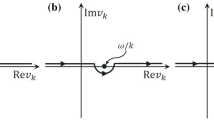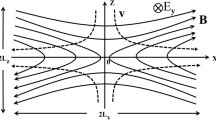Abstract
One of the main applications in plasma physics concerns the energy production through thermo-nuclear fusion. The controlled fusion is achieved by magnetic confinement i.e., the plasma is confined into a toroidal domain (tokamak) under the action of huge magnetic fields. Several models exist for describing the evolution of strongly magnetized plasmas, most of them by neglecting the collisions between particles. The subject matter of this paper is to investigate the effect of large magnetic fields with respect to a collision mechanism. We consider here linear collision Boltzmann operators and derive, by averaging with respect to the fast cyclotronic motion due to strong magnetic forces, their effective collision kernels.
Similar content being viewed by others
References
Ben Abdallah, N., Gamba, I.M., Klar, A.: The Milne problem for high field kinetic equations. SIAM J. Appl. Math. 64, 1709–1736 (2004)
Bogoliubov, N.N., Mitropolsky, Y.A.: Asymptotic Methods in the Theory of Nonlinear Oscillations. Gordon & Breach, New York (1961)
Bostan, M.: The Vlasov-Poisson system with strong external magnetic field. Finite Larmor radius regime. Asymptot. Anal. 61, 91–123 (2009)
Bostan, M.: Transport equations with disparate advection fields. Application to the gyrokinetic models in plasma physics. J. Differ. Equ. 249, 1620–1663 (2010)
Bostan, M.: Gyrokinetic Vlasov equation in three dimensional setting. Second order approximation. SIAM J. Multiscale Model. Simul. 8, 1923–1957 (2010)
Bostan, M.: Transport of charged particles under fast oscillating magnetic fields. SIAM J. Math. Anal. 44, 1415–1447 (2012)
Bostan, M., Gamba, I.M., Goudon, T.: The linear Boltzmann equation with space periodic electric field. In: Nonlinear Partial Differential Equations and Related Topics. Transl. Am. Math. Soc., vol. 2(229), pp. 51–66. Am. Math. Soc., Providence (2010)
Bostan, M., Gamba, I.M., Goudon, T., Vasseur, A.: Boundary value problems for the stationary Vlasov-Boltzmann-Poisson equation. Indiana Univ. Math. J. 59, 1629–1660 (2010)
Bostan, M., Negulescu, C.: Mathematical models for strongly magnetized plasmas with mass disparate particles. Discrete Contin. Dyn. Syst., Ser. B 15, 513–544 (2011)
Brizard, A.J.: A guiding-center Fokker-Planck collision operator for nonuniform magnetic fields. Phys. Plasmas 11, 4429–4438 (2004)
Brizard, A.J., Hahm, T.S.: Foundations of nonlinear gyrokinetic theory. Rev. Mod. Phys. 79, 421–468 (2007)
Cercignani, C.: The Boltzmann Equation and Its Applications. Springer, New York (1988)
Cercignani, C., Gamba, I.M., Levermore, C.D.: High field approximations to a Boltzmann-Poisson system boundary conditions in a semiconductor. Appl. Math. Lett. 10, 111–118 (1997)
Cercignani, C., Gamba, I.M., Levermore, C.D.: A drift-collision balance asymptotic for a Boltzmann-Poisson system in bounded domains. SIAM J. Appl. Math. 61, 1932–1958 (2001)
Cercignani, C., Illner, R., Pulvirenti, M.: The Mathematical Theory of Dilute Gases. Springer, Berlin (1994)
Frénod, E., Sonnendrücker, E.: Homogenization of the Vlasov equation and of the Vlasov-Poisson system with strong external magnetic field. Asymptot. Anal. 18, 193–213 (1998)
Garbet, X., Dif-Pradalier, G., Nguyen, C., Sarazin, Y., Grandgirard, V., Ghendrih, Ph.: Neoclassical equilibrium in gyrokinetic simulations. Phys. Plasmas 16 (2009)
Garbet, X.: Towards a full self-consistent numerical simulation of tokamak plasma turbulence. Plasma Phys. Control. Fusion 39 (1997)
Garbet, X.: Turbulence modeling in fusion plasmas. Europhys. News 29 (1998)
Golse, F., Saint-Raymond, L.: The Vlasov-Poisson system with strong magnetic field. J. Math. Pures Appl. 78, 791–817 (1999)
Grandgirard, V., Brunetti, M., Bertrand, P., Besse, N., Garbet, X., Ghendrih, P., Manfredi, G., Sarazin, Y., Sauter, O., Sonnendrücker, E., Vaclavik, J., Villard, L.: A drift-kinetic semi-Lagrangian 4D code for ion turbulence simulation. J. Comput. Phys. 217, 395–423 (2006)
Hazeltine, R.D., Meiss, J.D.: Plasma Confinement. Dover, Mineola, New York (2003)
Littlejohn, R.G.: A guiding center Hamiltonian: a new approach. J. Math. Phys. 20, 2445–2458 (1979)
Littlejohn, R.G.: Hamiltonian formulation of guiding center motion. Phys. Fluids 24, 1730–1749 (1981)
Markowich, P.A., Ringhofer, C., Schmeiser, C.: Semiconductor Equations. Springer, New York (1990)
Poupaud, F.: Runaway phenomena and fluid approximation under high fields in semiconductor kinetic theory. Z. Angew. Math. Mech. 72, 359–372 (1992)
Rax, J.-M.: Physique des Plasmas, Cours et Applications. Dunod, Paris (2007)
Rudin, W.: Principles of Mathematical Analysis. McGraw-Hill, New York (1976)
Xu, X.Q., Rosenbluth, M.N.: Numerical simulation of ion-temperature-gradient-driven modes. Phys. Fluids, B 3, 627–643 (1991)
Acknowledgements
This work was initiated during the visit of the first author at the University of Texas at Austin. The second author acknowledges partial support from NSF grant DMS 1109625. Support from the Institute for Computational Engineering and Sciences at the University of Texas at Austin is also gratefully acknowledged.
Author information
Authors and Affiliations
Corresponding author
Proofs of Propositions 3.5, 3.6
Proofs of Propositions 3.5, 3.6
Proof of Proposition 3.5
1. We show that y→(ψ 0(y),…,ψ m−1(y)) is a change of coordinates. Indeed, if \(y, \overline{y} \in\mathbb{R}^{m}\) verify \(\psi_{i} (y) = \psi_{i} (\overline{y})\), i∈{0,1,…,m−1}, then \(y, \overline{y}\) belong to the same characteristic. Thus denoting by y 0 the discontinuity point of ψ 0 on this characteristic, there are \(h, \overline{h} \in[0,T_{c}(y_{0}))\), with \(h \leq\overline {h}\) without loss of generality, such that \(y = Y(h;y_{0}), \overline{y} = Y(\overline{h};y_{0})\). Integrating (b 0⋅∇ y ψ 0)(Y(s;y 0))=I(Y(s;y 0))=I(y 0) between h and \(\overline{h}\) we obtain
Therefore \(h = \overline{h}\) which implies \(y = \overline{y}\). We have shown that y∈ℝm is uniquely determined by ψ 0(y),…,ψ m−1(y). Indeed, y belongs to the characteristic associated to the invariants ψ 1(y),…,ψ m−1(y) and, if we denote by y 0 the discontinuity point of ψ 0 on this characteristic, we have y=Y(s;y 0), where the parameter s∈[0,T c (y)) is determined by
Finally, without loss of generality we suppose that ψ 0(y 0)=0 and thus ψ 0(y)∈[0,T c (y 0)I(y 0))=[0,[ψ 0])=[0,S). Clearly the map y→(ψ 0(y),…,ψ m−1(y)) is a surjection between ℝm and [0,S)×D, which shows 1.
2. Notice that ∇ y ψ 0∉span{∇ y ψ 1,…,∇ y ψ m−1} since b 0⋅∇ y ψ 0≠0 and b 0⋅∇ y ψ 1=⋯=b 0⋅∇ y ψ m−1=0. Thus, for any i∈{1,…,m−1} there is a unique vector field b i such that
which proves 2. □
Proof of Proposition 3.6
Notice that for any y∈ℝm the function
is continuous on ℝ. In particular this holds true for any discontinuity point y 0 of ψ 0. For any y=Y(s;y 0), s∈(0,T c (y 0)) we can write

It remains to analyze the differentiability around the point y 0. Without loss of generality we assume that I>0. Taking s>0 one gets

where \(\partial_{\psi_{0}} w_{+}\) stands for the right derivative of w with respect to ψ 0. Taking now s<0, using the S-periodicity of w with respect to ψ 0, we obtain

where \(\partial_{\psi_{0}} w_{-}\) stands for the left derivative of w with respect to ψ 0. Combining (75), (76) we deduce that w is differentiable with respect to ψ 0 and at any point y∈ℝm
Moreover, for any i∈{1,…,m−1} we have
□
Rights and permissions
About this article
Cite this article
Bostan, M., Gamba, I.M. Impact of Strong Magnetic Fields on Collision Mechanism for Transport of Charged Particles. J Stat Phys 148, 856–895 (2012). https://doi.org/10.1007/s10955-012-0560-4
Received:
Accepted:
Published:
Issue Date:
DOI: https://doi.org/10.1007/s10955-012-0560-4




